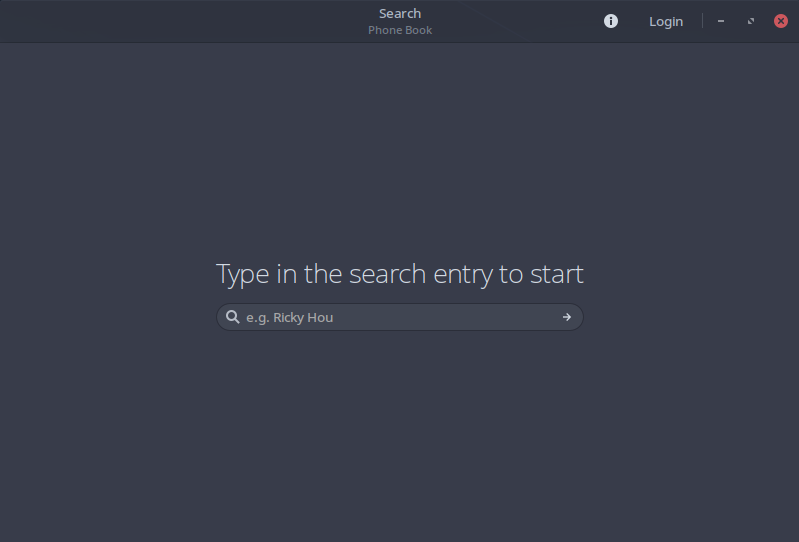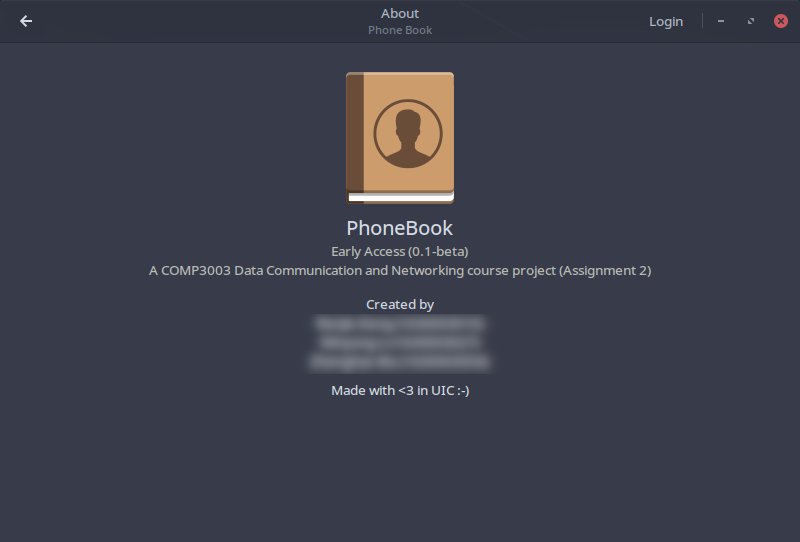Controlling GTK Widgets on GtkStack Page Switch
TL;DR: Connect callbacks to the signal GtkWidget::map of the stack children.
In some cases, you may have a GtkStack without a GtkStackSwitcher to easily create several “interfaces” in a region, but as pages switch other actions are required to perform in order to cooperate with the stack switching. For example, PhoneBook, a course project of my group on networking in the past semester, has several interfaces switched according to user actions like button press and searching result reaching.

Figure 1. Main Page of The PhoneBook Application

Figure 2. About Page of The PhoneBook Application
As you can see, in Figure 1 we have an about button on the right of the header bar (on the left of “Login” button), but in Figure 2 we have a “go back” button on the left instead, without any button on the right. We I designed these two button as:
- Left button, acting as a “back” button when in need.
- Right button, acting as either an “about” button, an “edit” button, or a “submit” button.
You can see the full logic here in the code.
Now, what we want to do is to let GTK calls our callback to change the states of these buttons once the stack is switched. However, GtkStack does not provide such signal for us to connect to (it does not even emit signals by itself)1.
As almost all GTK widgets are sub-classes of GtkWidget, I looked through all signals emitted by GtkWidget (it is a quite long list), and tried to find a signal that is emitted once the widget shows up on the screen. Finally, I found the ::map signal and the ::map-event signal of GtkWidget:
/* Prototype of callback of ::map, Run First */
void
user_function (GtkWidget *widget,
gpointer user_data)
/* Prototype of callback of ::map-event, Run Last */
gboolean
user_function (GtkWidget *widget,
GdkEvent *event,
gpointer user_data)
Signal ::map is emitted when a widget is going to be drawn2, while signal ::map-event is emitted when a widget has been drown (::map has occurred). In addition, to receive ::map-event, a proper GDK mask is required to be set.3 Since we only want to associate buttons to stack page switches, these two signals make no difference to me. I chose to connect my callback to the ::map signal to children of GtkStack. The following is a piece of sample code snippet showing how to write the callback function:
/**
* The following callback function requires:
*
* - GtkBuilder to be used as the constructing method of UI;
* - the "swap" attribute be set in Glade (i.e. GtkBuilder UI definition file);
* - the default user data of callbacks be the GtkBuilder;
*/
void stack_switch_cb(GtkBuilder *builder)
{
/* Get widgets we want to operate on from GtkBuilder */
GtkWidget *btn_l = GTK_WIDGET(gtk_builder_get_object(builder, "btn_left"));
GtkWidget *btn_r = GTK_WIDGET(gtk_builder_get_object(builder, "btn_right"));
/* Get the name of the stack page to switch to */
const char *stack_page_name = gtk_stack_get_visible_child_name(
GTK_STACK(gtk_builder_get_object(builder, "stack"))
);
/* Determine what to do according to the name of stack page (must be set in prior) */
if (g_strcmp0(stack_page_name, "main") == 0) {
/* ... */
} else {
/* ... */
}
}
(See my last blog post for my reasons to do the above)
In this way, when a stack page is going to be shown, the function is called and actions are performed with the switch of GtkStack. Either the page is switched with GtkStackSwitcher, by user actions, or by other means, these actions are guaranteed to be performed, and thus widgets can be associated with the show of corresponding stack pages!